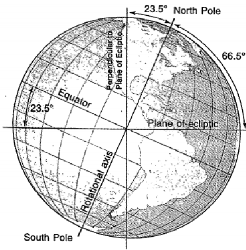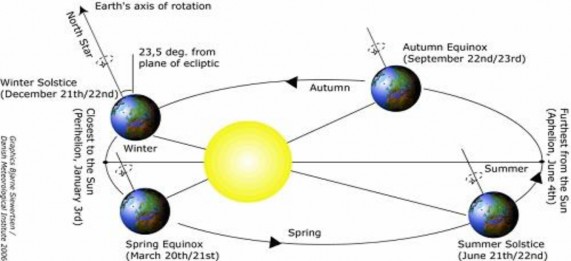7.2.3. Varying Lengths of Day and Night

The axis of the earth is inclined to the plane of the ecliptic (the plane in which the earth orbits round the sun) at an angle of 66⅟2°, giving rise to different seasons and varying lengths of day and night. If the axis were perpendicular to this plane, all parts of the globe would have equal days and night at all times of the year, but we know this is not so. In the hemisphere in winter as we go northwards, the hours of darkness steadily increase. At the Arctic Circle (66⅟2°) the sun never ‘rise’ and there is darkness for the whole day in mid- winter on 22 December. Beyond the Arctic Circle the number of days with complete darkness increases, until we reach the North Pole (90°N) when half the year will have darkness. In the summer (June) conditions are exactly reversed. Daylight increases as we go polewards. At the Arctic Circle, the sun never ‘sets’ at mid-summer (21 June) and there is a complete 24-hour period of continuous daylight. In summer, the region north of the Arctic Circle is popularly referred to as “Land of the Mid-Night Sun’. At the North Pole, there will be six months of continuous daylight.
In the southern hemisphere, the same process takes place, except that the conditions are reversed. When it is summer in the northern hemisphere, the southern conditions will experience winter. Mid- summer at the North Pole will be mid-winter at the South Pole.


Revolution of Earth
7.2.4. The Altitude of the Midday Sun

In the course of a year, the earth’s revolution round the sun with its axis inclined at 66⅟2 to the plane of the ecliptic changes the apparent altitude of the midday sun. The sun is vertically overhead at the equator on two days each year. These are usually 21 March and 21 September though the date changes because a year is not exactly 365 days. These two days are termed equinoxes meaning ‘ equal nights’ because on these two days all parts of the world have equal days and nights. After the March equinox the sun appears to move north and is vertically overhead at the Tropic of Cancer (23⅟2°N) on about 21 June. This is known as the June or summer solstice when the northern hemisphere will have its longest day and shortest night. By about 22 December, the sun will be overhead at the Tropic of Capricorn (23⅟2°S). This is the winter solstice when the southern hemisphere will have its longest day and shortest night. The Tropics thus marks the limits of the overhead sun, for beyond these, the sun is never overhead at any time of the year. Such regions are marked by distinct seasonal changes- spring, summer, autumn and winter. Beyond the Arctic Circle(66⅟2°N) and the Antarctic Circle (66⅟2°S)where darkness lasts for 6 months and daylight is continuous for the remaining half of the year, it is always cold; for even during the short summer the sun is never high in the sky. Within the tropics, as the midday sun varies very little from its vertical position at noon daily, the four seasons are almost equal all the year round.
